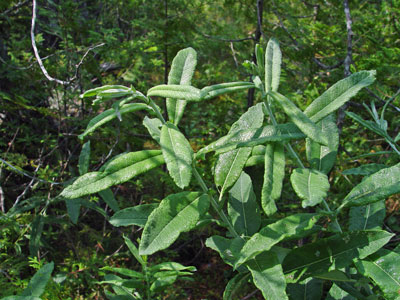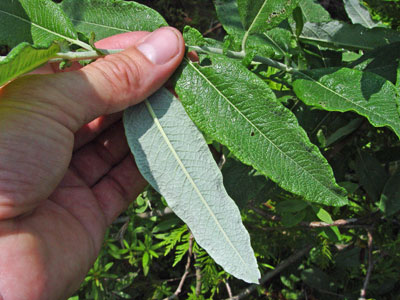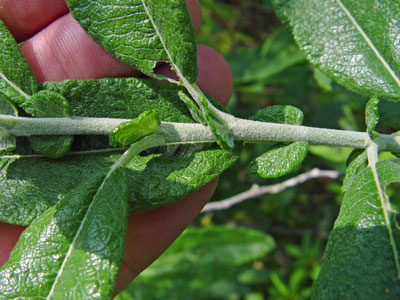DACF Home → Bureaus & Programs → Maine Natural Areas Program → Communities, Plants, and Animals → Rare Plants → Salix candida

Salix candida Fluegge ex Willd.
Hoary Willow
- State Rank: S1
- Global Rank: G5
- State Status: Endangered
Habitat: Calcareous bogs and thickets. [Forested wetland; Open wetland, not coastal nor rivershore (non-forested, wetland); Non-tidal rivershore (non-forested, seasonally wet)]
Range: Newfoundland to Athabasca, Wyoming, New Jersey, Pennsylvania, Iowa and South Dakota.

Aids to Identification: Willows are recognized by their winter buds and flowers. Their buds are covered by a single, cap-like scale, and their flowers are very small and are borne in catkins. Identification of willows is complicated by the fact that these plants are dioecious - the staminate and carpellate flowers are borne on separate plants. The hoary willow is a shrub that grows in clumps, 1-3 m high and has oblong, tapering leaves 5-10 cm long, greyish green and covered beneath with dense white woolly hairs. (The leaves resemble those of garden sage, hence its other common name of sage willow.) Often confused with S. pellita, a species of northern and western Maine rivershores. S. pellita usually has glabrous twigs, lacks stipules, and leaves with semi-lustrous pubescence. S. candida usually has tomentose twigs, has small stipules, and leaves with dull pubescence.

Ecological characteristics: All occurrences in Maine have been from circumneutral fens.
Phenology: Flowers in May.
Family: Salicaceae
Synonyms: Salix candida Fluegge ex Willd. var. denudata Anderss.; Salix candida Fluegge ex Willd. var. tomentosa Anderss.
Known Distribution in Maine: This rare plant has been documented from a total of 5 town(s) in the following county(ies): Aroostook.
Reason(s) for rarity: Natural scarcity of suitable (i.e. calcareous) habitat.
Conservation considerations: The single currently known Maine population is not particularly vulnerable to human activities. Although a small and very local population, it has persisted for decades at least.